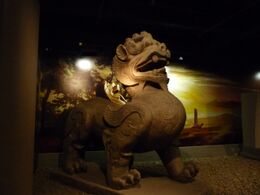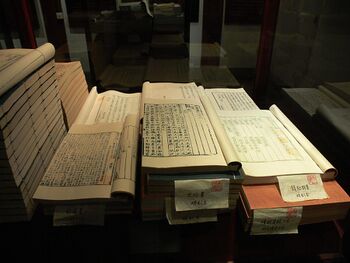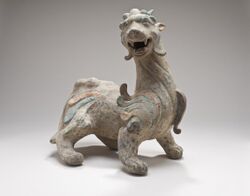Unsolved:Pixiu
| Pixiu |
|---|


Pixiu (貔貅; píxiū; P'i-hsiu) is a Chinese mythical hybrid creature, commonly (but incorrectly) referred to in the West by the Greek word "chimera", and considered a powerful protector of practitioners of Feng Shui. It resembles a strong, winged lion. Pixiu is an earth and sea variation, particularly an influential and auspicious creature for wealth. It is said to have a voracious appetite towards only gold, silver and jewels. Therefore, traditionally to the Chinese, Pixiu have always been regarded as auspicious creatures that possessed mystical powers capable of drawing Cai Qi (財氣 wealth) from all directions.[1][2] Because of this, according to Chinese zodiac, it is especially helpful for those who are going through a bad year.
There are two different types of Pixiu, a male and a female. The physical difference is seen by their antlers. The one with two antlers is the female of the species and is called a "Bìxié" and the one with one antler is the male of the species and is called a "Tiān lù".[3]
- Bìxié (辟邪; bìxié; pi-hsieh; lit. "to ward off evil spirits") - The female of the species; wards off evil. It is also believed that Bìxié has the ability of assisting anyone who is suffering from bad Feng Shui that is due to having offended the Grand Duke Jupiter (also called Tai sui (太岁)).
- Tiān lù (天祿; tiānlù; t'ien-lu) - The male of the species; in charge of wealth. Tiān lù is said to go out into the world in search of gold and other forms of wealth and, bringing it home to its Master, the Bìxié is then said to hold onto it, guarding it within the home of the Master. Displaying Tiān lù at home or in the office is said to prevent wealth from flowing away.
Pixiu crave the smell of gold and silver and like to bring their masters money in their mouth. Statues of this creature are often used to attract wealth in feng shui.[4][5]
Today, Pixiu are also a popular design on jade pendants. It was also featured as a design on the sword of Fa Mulan's character in the 1998 Disney animated feature Mulan.
Characteristics
Fierce-looking and covered with whitish-grey fur, Pixiu are a type of auspicious, winged animal, written about in ancient Chinese history and heralded through the millennia by fantastic stories of powerful and grandiose feats of victory in battle.[6] Their fantastic legend has been passed down through two-thousand years of Chinese lore. They have the powerful head of a Chinese dragon, the bold body of a lion, and—historically—sport on their heads either one antler (male) or two antlers (female). In modern times, the historical physical appearance of this legendary creature has been somewhat lost, and, as time has passed, it is now more commonly depicted with only one antler, which would be a male according to the ancient descriptions.[7]
Ancient Chinese descriptions, depictions and stone carvings of Pixiu from the Han dynasty (206 BC–220 AD) show the male with a single antler and the female with two. As with the Chinese Phoenix, the common image today is a representation of a single sex with one antler (male). Pixiu have protruding eyes and sharp teeth. Its strong body resembles a Chinese lion and its feet have paws and claws. There is one ancient, stone sculpture variation found with hooves, but all Pixiu always have wings. Many have a bifurcated (split) tail that hangs low and downward, covering their buttocks and rectums, a representative metaphor that they hold gold inside their stomachs but will not let it out.
Looking at the posture of Pixiu, the creatures seem to project a sense of strength, elegance and mobility. Likewise, they have a big, opened mouth ready to gobble up gold and fortunes for its master. Because of this, a Pixiu statue is often employed in the home as a way of receiving and keeping fortunes and wealth.
Imperial Pixiu used during the Qing dynasty developed the physical characteristic of a fatter, more rotund body, indicating a stomach that could be loaded with unlimited amounts of gold and all forms of wealth and good fortune.
Due to their similar appearances, the Pixiu is often confused with stone lions and "Qilin", but Pixiu can easily be distinguished apart from those two animals by its pair of feathered wings with which it can fly between Heaven and Earth.[4]
Mythology

One story of the Pixiu tells that it violated a law of Heaven by defecating on the floor of Heaven. When it was found out, it was punished by a spanking executed by the Jade Emperor. The spanking was hard enough to cause its rectum to be permanently sealed. The Jade Emperor further declared that the diet of the Pixiu would be restricted to gold, silver and jewels. This is why Pixiu can eat gold, silver and jewels but cannot expel it. This is one of the origins of the status of Pixiu statues as a symbol of the acquisition and preservation of wealth.
Another story says that Pixiu was the well-behaved, youngest son of the Dragon King and was spoiled by its parents. One day, Pixiu was playing on the Dragon King's desk and accidentally broke a very important seal that represented the power of the Dragon King. The Dragon King became very angry and used magic to turn Pixiu into an animal. He then sealed his rectum and declared that from then on, Pixiu could only eat things that represented wealth, such as gold, silver and jewels.[10]
Pixiu was reputed as a very fierce creature. The large fangs, visible in the creatures' snarling mouths, are used to attack demons and evil spirits, draining their essence and converting it to wealth. Pixiu also guard against disease caused by these same evil spirits. It is written that Pixiu patrols the Heavens to keep demons at bay and to protect their owners from all harm.[8]
It was believed that the ferociously devoted Pixiu would always and constantly guard its Master, even after he passed from this life into the next world. It was also believed that Pixiu would help their Masters ascend to heaven by flying them up to Heaven while they rode on their strong backs.[6]
History
"Pixiu" appear to have their origin in the Han dynasty (206 BC–220 AD) where they are found mentioned and were originally called "táo bá" in the Book of Han, an ancient written account of the history of China.

The Book of Han was completed in the year 111 A.D. In Chapter 96, it is written,
"In the country of Wū Gē Shān Lí there exist creatures called "táo bá" (meaning "selected peach"), lions and rhinoceros."[7][circular reference] -from the section entitled Accounts of the Western Regions.
An annotation is also found therein where the female and male "táo bá" are further described as having antlers like a deer, but the male, which was referred to as “Tiān lù", has only one antler, while the female, referred to as "Bìxié", has two antlers.
In tribute to the legend of the ferocity and prowess of the Pixiu in battle, the Pixiu became synonymous with the army in ancient China . In fact, the word "pixiu", interpreted as meaning "fierce beast" and also "brave warrior", was used as a symbol on battle flags and banners.[6]
The Emperor Wu of the Han dynasty, in ancient China, declared that the wonderful, magnificent and devoted Pixiu, who obtained and guarded the Master's gold, would be forever known as the "Treasure of the Emperor".[11] It is said that the Emperor declared that only Royal persons could possess a Pixiu and it was strictly forbidden for all others to own one, including officials.[11] This law was kept through to the end of the Qing dynasty.[11]
Chinese Architecture
During China's history, Pixiu were commonly displayed in ancient architecture to ward off Yin Qi (陰氣) and to harness auspicious Qi.
The statues of a Pixiu are commonly found on the four corners of the roofs of houses, palaces and halls of the most important people such as the Chinese Emperor. The Pixiu sits behind the dragon, the phoenix, the winged horse, the sea horse, and other, similar creatures in a guarding manner.
In ancient China, stone statues of Pixiu (Bixie) were also used as tomb guardians of Han dynasty emperors and other royal persons.
Feng Shui
In Feng shui, Pixiu (aka "Pi Yao" in some modern cultural translations) is the heavenly variation of a particularly powerful and auspicious creature of good fortune. They are said to have the power to assist anyone suffering from bad Feng shui due to having offended the Grand Duke Jupiter (Tai Sui). In 2005, the Grand Duke resided in the West, so those born in the year of the Rabbit will have been in conflict with him. Practitioners of Feng Shui should ensure that they display the Pixiu (Pi Yao) in the West to appease Tai Sui. The Pixiu (Pi Yao) should also be displayed in homes for those enduring a period of bad luck soon after moving into a new home or soon after undertaking renovations. In 2006, Tai Sui moved to the Northwest. His exact position in 2006 is West-Northwest.
- Pixiu (aka "Pi Yao" in some modern cultural translations) - must be placed facing out of the house.
- Displaying Pixiu' (Pi Yao) at the affected area of the house or office can avoid misfortune and disasters.
- For displaying towards openings or entrance, a pair of Pixiu' (Pi Yao) is needed.
- Tiān lù (male Pixiu with one antler) and Bìxié (female Pixiu with two antlers) - are utilized for attracting and keeping wealth; you may place them in the desired wealth area, such as an attractive wealth area or an accumulative wealth area.
- Do not place Pixiu facing directly on any person like a confronting position.
- Ideally, Pixiu should not be place on the floor and they should never be placed above eye level.
- One cannot touch the mouth of Pixiu because the touching of their mouths would ruin the wealth.
See also
- Feng Shui
- Imperial guardian lion
- Qilin
- Unicorn
References and footnotes
- ↑ "天禄之家 WWW.tianlu.sg". http://www.tianlu.sg/yutianlu_eng.htm.
- ↑ "Archived copy". http://traditions.cultural-china.com/en/13Traditions2337.html.
- ↑ 3.0 3.1 "Error: no
|title=specified when using {{Cite web}}". http://www.onmarkproductions.com/html/hikyu-beast.html. - ↑ 4.0 4.1 4.2 4.3 4.4 Bates, Roy (2008). "Chapter 7". 29 Chinese Mysteries. Beijing, China: TuDragon Books Ltd. pp. 49.
- ↑ Bates, Roy (2008). "Chapter 7". 29 Chinese Mysteries. Beijing, China: TuDragon Books Ltd. pp. 48, 49.
- ↑ 6.0 6.1 6.2 "Tianlu and Bixie". http://traditions.cultural-china.com/en/13Traditions1548.html.
- ↑ 7.0 7.1 "Book of Han". https://en.wikipedia.org/wiki/Book_of_Han.
- ↑ 8.0 8.1 Bates, Roy (2008). "Chapter 7". 29 Chinese Mysteries. Beijing, China: TuDragon Books, Ltd. p. 49.
- ↑ "Animal Bixie en jade, Dynastie Han (206 av. J.-C.-220)" (in French). https://www.npm.gov.tw/fr/Article.aspx?sNo=04001022&print=1.
- ↑ Bates, Roy (2008). "Chapter 7". 29 Chinese Mysteries. Beijing, China: TuDragon Books Ltd. pp. 51.
- ↑ 11.0 11.1 11.2 Li, Jinn (2015). Pi Xiu Celestial Coming with Fortune. Estalontech (PublishDrive). ISBN 9789634280958.
External links





